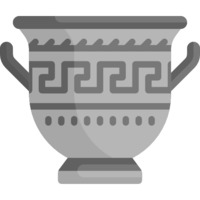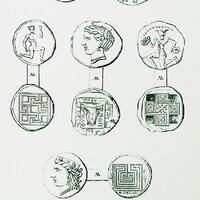Κνωσός
Αντικείμενο
Τίτλος Σημείου Ενδιαφέροντος
el
Κνωσός
en
Knossos
Περιγραφή / Απόσπασμα
269-276
en
From Cave-bridge I proceeded to Mákro-teikho, undoubtedly the site of Cnossos. All the now existing vestiges of the ancient “metropolis” of Crete, are some rude masses of Roman brick-work", part of the so-called long wall from which the modern name of the
site has been derived.
site has been derived.
Σύγχρονη περιγραφή
el
Η Κνωσός είναι το σημαντικότερο κέντρο του Μινωικού Πολιτισμού και είναι χτισμένη στο ύψωμα της Κεφάλας. Κατά την παράδοση, υπήρξε η έδρα του θρυλικού βασιλιά Μίνωα, ο οποίος δεν ήταν ένα πρόσωπο, αλλά μια σειρά από βασιλιάδες με το ίδιο όνομα (όπως οι Φαραώ στην Άιγυπτο). Η πόλη της Kνωσού κατοικήθηκε συνεχώς από τα τέλη της 7ης χιλιετίας έως και τα ρωμαϊκά χρόνια. Η οικονομική, κοινωνική και πολιτική ανάπτυξη του οικισμού οδήγησε γύρω στα τέλη της δεύτερης χιλιετίας π.Χ. στην ανέγερση του πρώτου μεγαλοπρεπούς ανακτόρου, το οποίο καταστράφηκε, πιθανότατα από σεισμό. Το δεύτερο, μεγαλοπρεπέστερο ανάκτορο κατασκευάστηκε πάνω στα ερείπια του παλαιού και η πόλη της Κνωσού αναπτύχθηκε σε μεγάλη έκταση, ενώ ο πληθυσμός της υπολογίστηκε από τον Evans γύρω στους 80.000 κατοίκους. Το 1450 π.Χ., μετά από μερική καταστροφή της Κνωσού, εγκαταστάθηκαν στην πόλη Μυκηναίοι. Τελικά, το ανάκτορο καταστράφηκε οριστικά το 1350 π.Χ. από μεγάλη πυρκαγιά.
Οι πρώτες ανασκαφές έγιναν το 1878 από τον εύπορο αρχαιολάτρη Ηρακλειώτη Μίνωα Καλοκαιρινό, όσο η Κρήτη βρισκόταν ακόμη υπό τουρκική κατοχή. Ακολούθησαν οι ανασκαφές που διεξήγαγε ο Άγγλος Sir Arthur Evans (1900-1931) όχι μόνο στο ανάκτορο, που ουσιαστικά το ανακατασκεύασε με τσιμέντο, αλλά και την ευρύτερη περιοχή της Κνωσού.
Το ανάκτορο της Κνωσού ήταν πολυώροφο και κάλυπτε έκταση 20.000 τ.μ., ενώ εντύπωση προκαλούν οι πρωτότυπες αρχιτεκτονικές και κατασκευαστικές επινοήσεις, η ποικιλία των δομικών υλικών, τα χρωματιστά κονιάματα, οι ορθομαρμαρώσεις και οι τοιχογραφίες, καθώς και το σύνθετο αποχετευτικό και υδρευτικό δίκτυο. Τα πολυάριθμα και εξαιρετικά ευρήματα από το ανάκτορο, όπως αγγεία, σκεύη, ειδώλια, το αρχείο πινακίδων της Γραμμικής Β γραφής, καθώς και τα πρωτότυπα των τοιχογραφιών, φυλάσσονται σήμερα στο Αρχαιολογικό Μουσείο Ηρακλείου.
Οι πρώτες ανασκαφές έγιναν το 1878 από τον εύπορο αρχαιολάτρη Ηρακλειώτη Μίνωα Καλοκαιρινό, όσο η Κρήτη βρισκόταν ακόμη υπό τουρκική κατοχή. Ακολούθησαν οι ανασκαφές που διεξήγαγε ο Άγγλος Sir Arthur Evans (1900-1931) όχι μόνο στο ανάκτορο, που ουσιαστικά το ανακατασκεύασε με τσιμέντο, αλλά και την ευρύτερη περιοχή της Κνωσού.
Το ανάκτορο της Κνωσού ήταν πολυώροφο και κάλυπτε έκταση 20.000 τ.μ., ενώ εντύπωση προκαλούν οι πρωτότυπες αρχιτεκτονικές και κατασκευαστικές επινοήσεις, η ποικιλία των δομικών υλικών, τα χρωματιστά κονιάματα, οι ορθομαρμαρώσεις και οι τοιχογραφίες, καθώς και το σύνθετο αποχετευτικό και υδρευτικό δίκτυο. Τα πολυάριθμα και εξαιρετικά ευρήματα από το ανάκτορο, όπως αγγεία, σκεύη, ειδώλια, το αρχείο πινακίδων της Γραμμικής Β γραφής, καθώς και τα πρωτότυπα των τοιχογραφιών, φυλάσσονται σήμερα στο Αρχαιολογικό Μουσείο Ηρακλείου.
en
Knossos is the most important centre of the Minoan Civilization and is built on the hill of Kefala. According to tradition, it was the seat of the legendary King Minos, who was not a single person, but a series of kings by the same name (like the Pharaohs in Egypt). The city of Knossos was continuously inhabited from the end of the 7th millennium until the Roman years.
At about the end of the second millennium BC, the economic, social and political development of the settlement led to the construction of the first majestic palace, which was destroyed, most likely by an earthquake.
The second, even more majestic palace was built on the ruins of the old one and the city of Knossos developed to a large extent, with Evans estimating its population at around 80,000 inhabitants. In 1450 BC, after a partial destruction of Knossos, Mycenaeans settled in the city. Eventually, the palace was permanently destroyed in 1350 BC. due to a large fire.
The first excavations took place in 1878 by the wealthy archaeologist from Heraklion Minos Kalokairinos, while Crete was still under Turkish occupation. The excavations that followed were carried out by the Englishman Sir Arthur Evans (1900-1931) and regarded not only the palace, which essentially was reconstructed with cement, but also the wider area of Knossos.
The palace of Knossos was a multi-storey one and covered an area of 20.000 sq.m., while the original architectural and construction inventions, the variety of building materials, the coloured mortars, the marble revetments and the frescoes, as well as the complex water supply and drainage network are impressive. Numerous and exceptional findings from the palace, such as vases, utensils, figurines, the tablets with Linear B writing, as well as the originals of the frescoes, are displayed today in the Archaeological Museum of Heraklion.
At about the end of the second millennium BC, the economic, social and political development of the settlement led to the construction of the first majestic palace, which was destroyed, most likely by an earthquake.
The second, even more majestic palace was built on the ruins of the old one and the city of Knossos developed to a large extent, with Evans estimating its population at around 80,000 inhabitants. In 1450 BC, after a partial destruction of Knossos, Mycenaeans settled in the city. Eventually, the palace was permanently destroyed in 1350 BC. due to a large fire.
The first excavations took place in 1878 by the wealthy archaeologist from Heraklion Minos Kalokairinos, while Crete was still under Turkish occupation. The excavations that followed were carried out by the Englishman Sir Arthur Evans (1900-1931) and regarded not only the palace, which essentially was reconstructed with cement, but also the wider area of Knossos.
The palace of Knossos was a multi-storey one and covered an area of 20.000 sq.m., while the original architectural and construction inventions, the variety of building materials, the coloured mortars, the marble revetments and the frescoes, as well as the complex water supply and drainage network are impressive. Numerous and exceptional findings from the palace, such as vases, utensils, figurines, the tablets with Linear B writing, as well as the originals of the frescoes, are displayed today in the Archaeological Museum of Heraklion.





